Kia Sportage: Specifications, Components and Components Location | Head Lamps
Specifications
Specifications
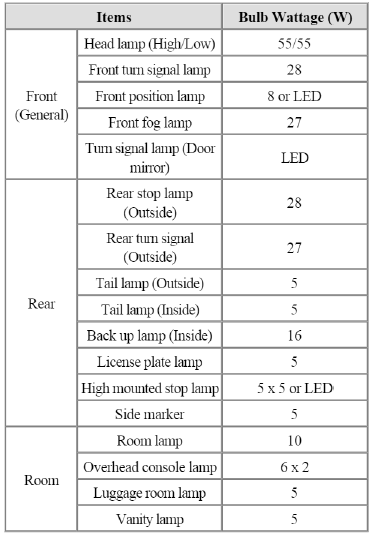
Components and Components Location
Component Location (1)
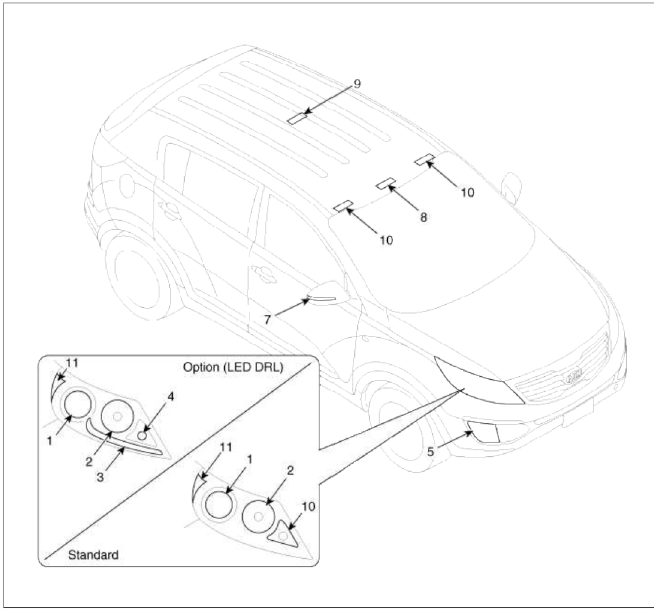
- Head lamp (Low)
- Head lamp (High)
- DRL & position LED
- Front torn signal lamp
- Front fog lamp
- Door mirror turn signal lamp (LED)
- Overhead lamp
- Room lamp
- Vanity lamp
- Turn signal & position lamp
- Side marker
Component Location (2)
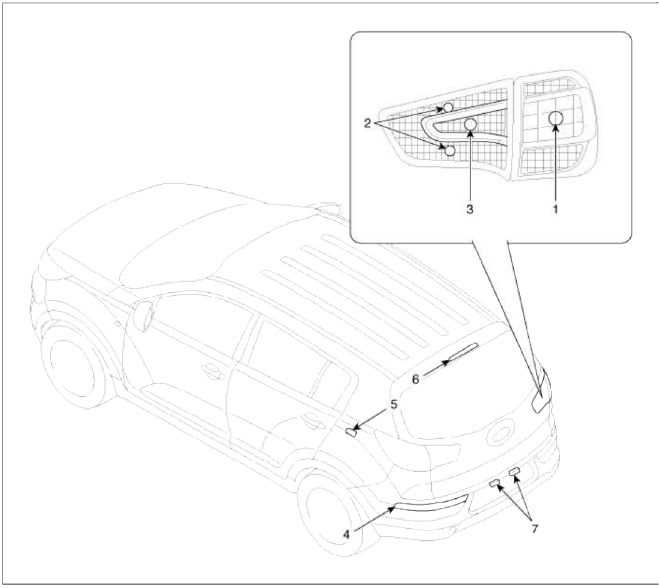
- Tail/Stop lamp
- Position lamp
- Back up lamp
- Rear turn signal lamp
- Luggage room lamp
- High mounted stop lamp
- License plate lamp
Head Lamps
Components and Components Location
Component
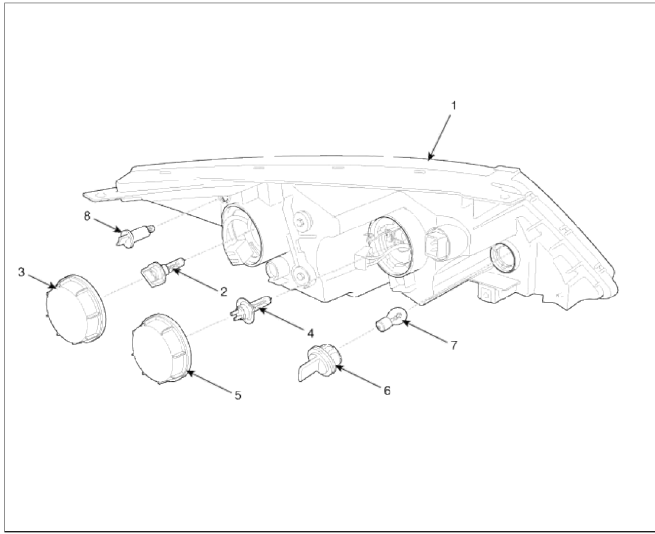
- Head lamp assembly lens and housing
- Head lamp (low) bulb
- Dust cap
- Head lamp (high) bulb
- Dust cap
- Turn signal lamp/tail lamp socket
- Turn signal lamp/tail lamp bulb
- Side marker bulb
Repair procedures
Removal
CAUTION
Head lamps become very hot during use; do not touch them or any attaching hardware immediately after they have been turned off.
NOTE
The headlamp bulb should not be removed from the headlamp assembly until just before a new bulb is installed.
Removing bulb for an extended period of time may affect headlamp bulb performance. Contaminants may enter the headlamp assembly where they can settle on the lens and reflector.
Never turn on the head lamps with the bulb removed from the headlamp assembly.
1. Disconnect the negative (-) battery terminal.
2. Loosen the mounting bolts (3EA) of head lamp. Disconnect the connector.
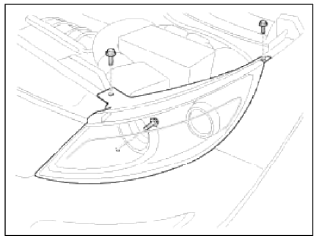
3. Remove the bolts and fasteners installed with the front bumper upper cover (A).
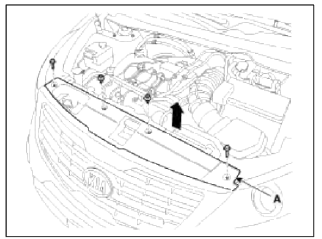
4. Remove the headlamp assembly (B) with spreading the radiator grill (A).
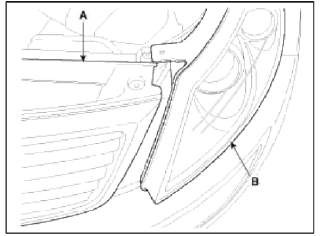
Installation
1. Install the head lamp bulbs.
2. Reassemble the head lamp bulb covers.
3. Reassemble the head lamp assembly after connecting the lamp connector.
Replacement
Head Lamp Bulb (Low)
1. Turn the head lamp switch off.
2. Remove the dust cover. Turn the bulb counterclockwise and remove it.
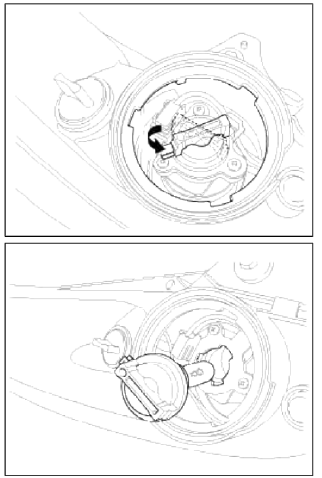
3. Installation is the reverse of removal.
Head Lamp Bulb (High)
1. Turn the head lamp switch off.
2. Remove the dust cap.
3. Disconnect the connector (A) and pin (B), remove the bulb.
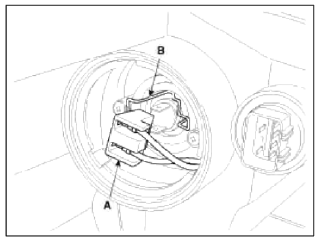
4. Installation is the reverse of removal.
Turn Signal Lamp
1. Turn the head lamp switch off.
2. Turn the bulb socket counterclockwise to remove the turn signal bulb (A).
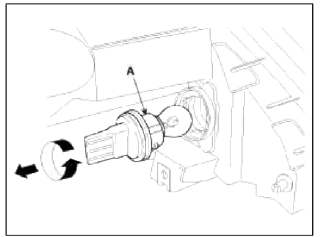
3. Installation is the reverse of removal.
Side Marker Bulb
1. Turn the bulb (A) counterclockwise and remove it.
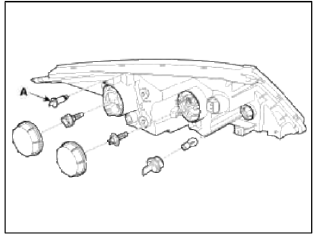
2. Installation is the reverse of removal.
Adjustment
Head Lamp Aiming Instructions
The head lamps should be aimed with the proper beam-setting equipment, and in accordance with the equipment manufacturer's instructions.
NOTE
If there are any regulations pertinent to the aiming of head lamps in the area where the vehicle is to be used, adjust so as to meet those requirements.
Alternately turn the adjusting gear to adjust the head lamp aiming. If beam-setting equipment is not available, proceed as follows:
1. Inflate the tires to the specified pressure and remove any loads from the vehicle except the driver, spare tire, and tools.
2. The vehicle should be placed on a flat floor.
3. Draw vertical lines (Vertical lines passing through respective head lamp centers) and a horizontal line (Horizontal line passing through center of head lamps) on the screen.
4. With the head lamp and battery in normal condition, arm the head lamps so the brightest portion falls on the vertical lines.
Make horizontal (A) adjustment to the lower beam using the adjusting wheel.
- General type
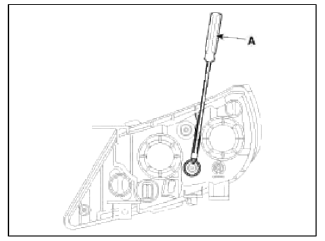
Front Fog Lamp Aiming
The front fog lamps should be aimed as the same manner of the head lamps aiming.
With the front fog lamps and battery normal condition, arm the front fog lamps by turning the adjusting gear (A).
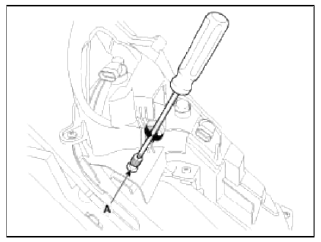
Head Lamp And Fog Lamp Aiming Point

H1 : Height between the head lamp bulb center and ground (Low beam) H2 : Height between the head lamp bulb center and ground (High beam) H3 : Height between the fog lamp bulb center and ground W1 : Distance between the two head lamp bulbs centers (Low beam) W2 : Distance between the two head lamp bulbs centers (High beam) W3 : Distance between the two fog lamp bulbs centers L : Distance between the head lamp bulb center and screen

1. General Type
- Turn the low beam on without driver aboard.
- The cut-off line should be projected in the allowable range (shaded region) shown in the picture.
- If head lamp leveling device is equipped, adjust the head lamp leveling device switch with 0 positions.
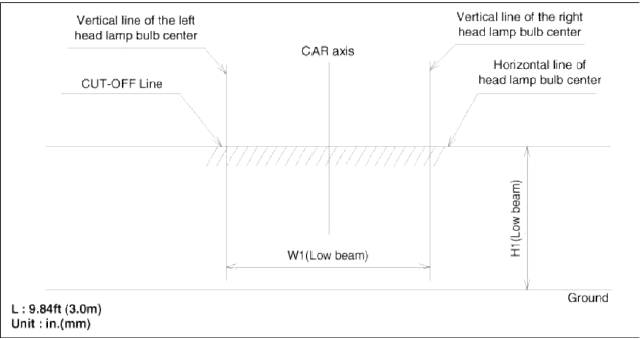
2. Turn the front fog lamp on with driver seated in the vehicle.
The cut-off line should be projected in the allowable range shown in the picture.
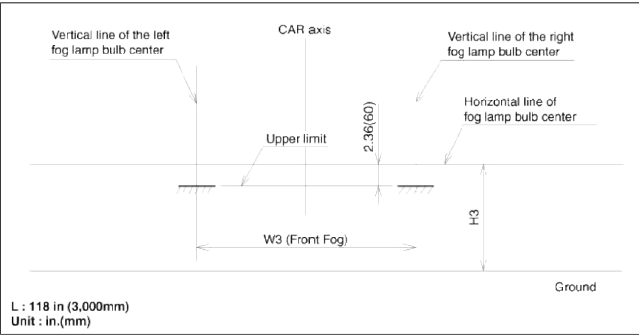
READ NEXT:
 Turn Signal Lamp | Room Lamp
Turn Signal Lamp | Room Lamp
Repair procedures
Removal
Rear Turn Signal Lamp
1. Disconnect the negative (-) battery terminal.
2. Remove the rear bumper.
(Refer to BD group - "Rear Bumper")
3. Disconnect the
SEE MORE:
 Active air flap
Active air flap
Active air flap system controls the air
flap below the front bumper to cool the
vehicle parts and improve energy efficiency.
Active air flap malfunction
Check Active Air Flap System
The active air flap system may not operate
normally if the air flap is temporarily
opened due to fo
 Audio system
Audio system
NOTICE
If you install an aftermarket HID headlamp,
your vehicle's audio and electronic
device may malfunction.
* If your vehicle is equipped with infotainment
system, refer to a separately
supplied manual for detailed information.
Sharkfin antenna
The sharkfin antenna transmits and
Content
- Home
- Kia Sportage - Fifth generation (NQ5) - (2022-2025) - Owner's Manual
- Kia Sportage - Second generation (JEKM) (2005-2015) - Body Workshop Manual
- Kia Sportage Third generation (SL) - (2011-2016) - Service and Repair Manual
- Sitemap
- Top articles